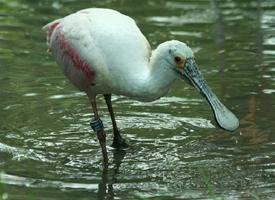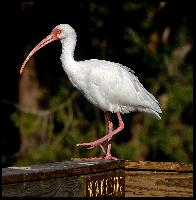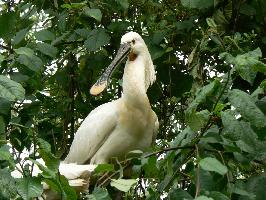
Poids et mesures
| Hauteur au garrot | 80 cm |
|---|---|
| Envergure des ailes | de 120 à 130 cm |
Description de l'animal
The Roseate Spoonbill, scientifically known as Platalea ajaja, is a striking and unique bird that inhabits the wetlands, marshes, and shallow coastal areas of the Americas, particularly from the southeastern United States through parts of Central America, the Caribbean, and South America as far south as Argentina and Chile. This species is easily recognizable by its distinctive features and vibrant coloration, making it a subject of fascination among birdwatchers and nature enthusiasts.One of the most remarkable characteristics of the Roseate Spoonbill is its spoon-shaped bill, from which it derives its name. This specialized bill is long, flat, and broad at the tip, resembling a spatula or spoon. This unique adaptation allows the bird to feed efficiently in shallow waters. The spoonbill sweeps its bill from side to side in the water to catch small fish, crustaceans, insects, and aquatic invertebrates. As the bird moves its bill through the mud and water, sensitive nerve endings detect prey, which is then swiftly snapped up.
The plumage of the Roseate Spoonbill is another feature that sets it apart from other birds. Adults boast a stunning pink coloration, which can range from pale pink to a more vibrant magenta hue, depending on factors such as diet, age, and geographical location. The intensity of the pink coloration is believed to be derived from the carotenoid pigments found in the crustaceans that make up a significant portion of their diet. The wings and tail may display a more intense shade of pink, and when in flight, the bird reveals a striking contrast of colors with its white neck, light underparts, and the vivid pink of its wings.
The Roseate Spoonbill is a medium to large bird, with adults typically reaching lengths of about 28 to 34 inches (70 to 86 cm) and wingspans of approximately 50 to 53 inches (127 to 135 cm). Both male and female spoonbills share similar plumage and physical characteristics, making them difficult to distinguish based on appearance alone.
Breeding behavior of the Roseate Spoonbill involves intricate displays, including bill clapping, deep bowing, and aerial flights. They are colonial nesters, often building nests in trees or shrubs in close proximity to other spoonbills or different species of wading birds. The nests are constructed from sticks and vegetation and lined with softer materials. Females typically lay 2 to 5 eggs, which both parents incubate.
The Roseate Spoonbill is a social bird, often seen in groups while feeding, flying, or roosting. Despite its vibrant appearance and fascinating behaviors, the species has faced threats from habitat loss, degradation of feeding grounds, and historical hunting for its feathers. Conservation efforts have been implemented in various regions to protect and preserve the habitats essential for the survival of this remarkable bird.
In summary, the Roseate Spoonbill is an extraordinary avian species, admired for its unique spoon-shaped bill and stunning pink plumage. Its presence adds a splash of color and beauty to the wetlands and coastal areas of the Americas, reminding us of the diversity and wonder of the natural world.
Animaux similaires
Nouvelles photos d'animaux
Top 10 des animaux
- Dolphin gull (Leucophaeus scoresbii)
- Japanese macaque (Macaca fuscata)
- Stone loach (Barbatula barbatula)
- Greek tortoise (Testudo graeca)
- Russian tortoise (Testudo horsfieldii)
- Galápagos tortoise (Geochelone nigra complex)
- Diana monkey (Cercopithecus diana)
- Moustached guenon (Cercopithecus cephus)
- Common flying dragon (Draco volans)
- Galápagos penguin (Spheniscus mendiculus)


